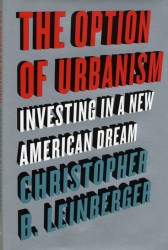The Option of Urbanism
More and more Americans are voting with their feet to live, work, and play in urban neighborhoods, but the government and big banks have been slow to respond to this change
More and more Americans are voting with their feet to live, work, and play in urban neighborhoods, but the government and big banks have been slow to respond to this change. In The Option of Urbanism: Investing in a New American Dream author Chris Leinberger explores the disconnect between what types of built environment people increasingly want, and how the market is often incentivized to build the exact opposite.
The Option of Urbanism begins by exploring the exact opposite of the book’s title. Leinberger spends much of the early part of the book examining how and why the suburbs as we know them today developed. He credits the Interstate Highway System as the biggest catalyst for this growth. He notes that a one-mile increase in the drivable radius adds three-fold to the amount of land available for development, which paired with government policies tilted towards suburban growth fueled greenfield development after World War II.
While much of suburbia was originally dominated by housing, The Option of Urbanism examines how Wall Street helped spur office and industrial development on the urban fringe by the reduction of real estate to the “nineteen standard real estate product types.” These standardized product types are by-and-large car-oriented, and allow collections of them to be easily traded on Wall Street. The author demonstrates how this new financing structure fuels short-term decision making over building and holding and has lead to the commoditization of real estate.
This suburban growth had numerous consequences, both positive and negative. On the positive side, drivable sub-urbanism has allowed countless Americans to have “a piece of dirt to call one’s own,” and made housing cheaper, amongst other positive side effects. On the down side, Leinberger notes it has also led to auto-dependence, the concentration of poverty, job access issues, a decline in water quality, and more.
The author spends much of the later half of the book exploring the evidence that walkable urbanism is in demand. He examines a visual preference survey that shows consumer demand for walkable neighborhoods (it not surprisingly is split close to 50/50 nationwide, similar to our electorate). He also looks at market studies that have found pent-up demand for residential and commercial walkable urbanism.
Christopher Leinberger concludes that the suburbs will still exist in the future, but an increasing number of people are choosing to live in a walkable urban neighborhood. He ends by noting that “the only question is whether the market will just take its course over many decades or whether walkable urbanism will be part of new American domestic policy to speed up the process. Either way it is coming.”
Excerpts
Where the built environment is headed…
So what is it going to be over the next generation: continued low-density, drivable sub-urbanism or a shift to compact walkable urbanism or some combination of the two?
I argue that demographic trends, consumer preferences, an emerging new version of the American Dream, and recognition of the consequences of drivable sub-urbanism are all pushing the pendulum back. The United States is on the verge of a new phase in constructing its built environment.
Infrastructure costs…
Most infrastructure categories, such as roads and sewer and water systems, have very high fixed costs. For example, the construction cost for building a mile of sewer line is reasonably similar in the suburbs and in the city. However, on a per-housing-unit basis, dividing that fixed cost over a small number of low-density houses means that it is far more expensive for each low-density house. If the taxes charged the homeowner to pay for the sewer line are similar for both low-density and high-density housing, as they tend to be, higher density walkable urbanism is massively subsidizing low-density drivable sub-urban development. For example, assume the sewer line costs $1 million per mile to build. If one mile of sewer line serves forty low-density houses in the suburbs, it costs $25,000 per house to install. If that mile of sewer line serves 400 high-density houses in a walkable urban place, it costs $2,500 per house.
Final Rating
3 out of 5 stars
This book is impressively short at 150 pages. It’s an easy read, but not overly simplified in any way. I would have enjoyed greater depth on a few subjects, but that easily could have sprawled the book to 400 pages. If you’re looking for an introductory book to urban real estate economics and the evolution of cities, this is a good book to consider.























Hi Urban Milwaukee,
I’m Kevin Dorival. “The Courage To Believe!” Inspirational autobiography – coming this Fall. I would love to speak with you about sending my book to your company for a book review. My target audience are teens and young adults and my goal is to help them make successful life decisions.
Strictly speaking, a one-mile increase in drivable radius results in a π-fold increase in area available for development.